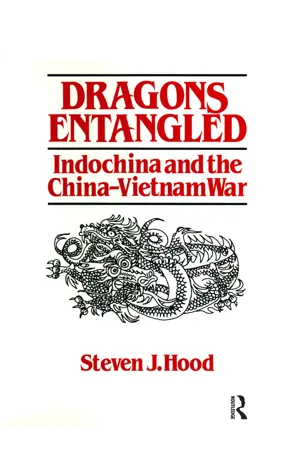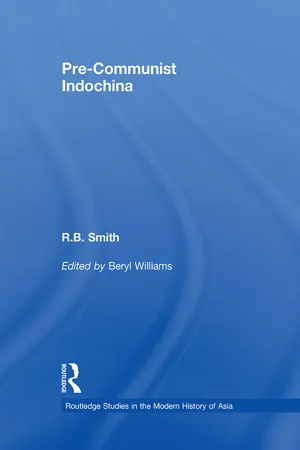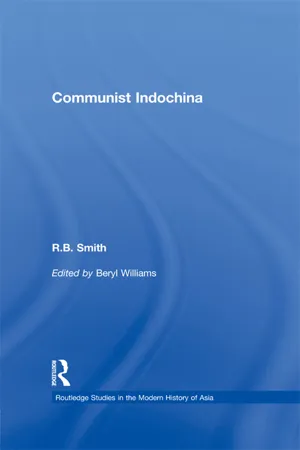History
Nguyen Dynasty
The Nguyen Dynasty was the last ruling dynasty of Vietnam, lasting from 1802 to 1945. It was established by Emperor Gia Long and marked a period of significant political and cultural changes in Vietnam. The dynasty faced challenges from French colonial expansion and internal conflicts, ultimately leading to its downfall and the end of imperial rule in Vietnam.
Written by Perlego with AI-assistance
Related key terms
6 Key excerpts on "Nguyen Dynasty"
- eBook - ePub
Dragons Entangled
Indochina and the China-Vietnam War
- Steven J. Hood(Author)
- 2019(Publication Date)
- Routledge(Publisher)
East Asia: Tradition and Transformation, Revised edition. Copyright © 1989 by Houghton Mifflin Co. Used with permission.The reason for Vietnam gaining independence by 939 was not because it had overthrown the Chinese, but rather because the Chinese were trying to settle their own internal power struggle. Out of this struggle came the organization of the Sung—a dynasty with little interest in Vietnam. The Vietnamese, therefore, were able to begin their own independent struggle and Ngo Quyen, who had fought the Chinese, became the founder of the first authentic dynasty of Vietnam.17 He proclaimed the valley areas of the Hue and Red rivers to be Vietnamese territory and thus claimed full independence from China.But Ngo was unable to maintain control over the people, who quickly lost their allegiance to the emperor and turned their loyalties to Dinh Bo Linh, a peasant who founded the Dinh dynasty. But Dinh was forced to step down after rival landlords had assassinated many of his family members. A period of instability ensued.Beginning in 1009, stability came to Vietnam. The Ly dynasty lasted for 215 years. This dynasty was able to consolidate power and subdue the ambitions of the various warlords. The Chinese tried to recapture Vietnam in 1057 and several times afterward, but the Vietnamese were able to repel the invasions.Government in Vietnam closely resembled the Chinese model. Vietnam was divided into provinces, prefectures, and departments. Three-year civil service exams were held to recruit trained civil and military officials.In 1224, the Tran family began their dynastic rule which lasted until 1400. They proved to be successful in building dikes along the rivers, draining swamps, and continuing to train a powerful military force. This was necessary as not only did they have to worry about the Mongolians who were now conquering China, but they also had to worry about the extreme south (of Vietnam).18 - eBook - ePub
- Peter Church(Author)
- 2017(Publication Date)
- Wiley(Publisher)
Whatever the developing differences, the Vietnamese perception of themselves as being fundamentally one people remained unquestioned. This was dramatically demonstrated in the Tay Son Rebellion which broke out in Vietnam in 1771. A vast “revolution from below,” the rebellion swept away the Nguyen and Trinh regimes which had divided Vietnam, and removed what was by that stage a nominal Le imperial dynasty. The rebels also repelled a Chinese invasion, and turned on Chinese merchants in Vietnam. They faltered only when faced with the tasks of practical government. A member of the southern Nguyen clan, Nguyen Anh, raised forces and, by 1802, managed to subdue the rebel forces. He became the emperor Gia Long, first of Vietnam's Nguyen emperors and the first ruler to preside over a united Vietnam for more than two centuries.THE 19TH‐CENTURY CONFUCIAN REVIVAL
Emperor from 1802 to 1820, Gia Long recognised what an administrative and defence nightmare Vietnam's geography had become—two fertile deltas, 1,000 kilometres apart, connected by a narrow coastal corridor. Ignoring Hanoi (and thus incurring northerner resentment), he established his capital in the centre of the country, at Hué. There he built a palace complex that was a scaled‐down replica of Peking's Forbidden City. The symbolism was appropriate—Gia Long and his son, Minh Mang (emperor from 1820 to 1841), would attempt to establish in Vietnam the most thorough copy yet seen of Chinese administrative concepts and methods. Though honourably intentioned, the attempt would prove a disaster.From the 1830s onward, rebellion flared frequently in protest at the level of bureaucratic intervention in daily life, at the rigidities and absurdities of mandarinal decrees, and above all at the level of taxation demanded by the system. The renewed concern with Confucian models also diminished the ability of Nguyen imperial government to deal realistically with the growing challenges from the West. Some members of the Vietnamese scholar class recognised the need to study the West, but they were in the minority. Disastrously, Emperor Minh Mang and his successors (Thieu Tri, emperor 1841–47, and Tu Duc, emperor 1847–83) chose to confront and repress the religion of the West, Christianity. - eBook - ePub
A History of Southeast Asia
Critical Crossroads
- Anthony Reid(Author)
- 2015(Publication Date)
- Wiley-Blackwell(Publisher)
A new Nguyen Dynasty, Viet Nam’s last and most ambitious, thus began the mammoth task of seeking to integrate its entire S-shaped domains. Its roots were firmly in the south, and its military strength based on the battle-hardened southern warriors. Nguyen Anh ruled the center directly from his new capital of Hue near that of his ancestors in Phu Xuan, with the reign title Gia Long (1802–20). In the south he installed a governor necessarily tolerant of the Chinese, Christian, Cham, and Khmer diversities through which he had come to power. Only after his son succeeded with the reign name Minh Mang (1820–41) did sternly assimilationist policies produce a bitter Khmer rebellion in 1833, even sterner repression, and a legacy of ethnic hostility.In the north the new administration had to rely on the literati elite then enjoying its most creative phase. Some of its greatest works had already been written as the Dai Viet state was disintegrating, but a new dynasty presented the challenge of an empty slate. In effect the Nguyen regime undertook a neo-Confucian redefinition of the state, beginning in Tongking where it had little other basis for legitimacy except that which was offered by its literati collaborators. These scholars had educated the second ruler Minh Mang, who sought in Confucian virtue a solution to the many challenges assailing the country. He attempted to impose this orthodoxy as a cure-all even in advancing the frontier of Han civilization at the expense of Cambodia. His neo-traditional reforms had a provisional quality not unlike the equally short-lived French regime that followed. Each was educating its future officials on radically new principles that were nevertheless unable to keep up with the pace of change. The Nguyen attempt at redefinition will be weighed in a broader context in Chapter 11 .The Commercial Expansion of a “Chinese Century,” 1740–1840
The Ming loyalist refugees of the seventeenth century had been exceptional in the long story of Chinese emigration. They consciously sought to use their muscle to build Chinese-style polities outside imperial control. The usual economic factors returned once the new Manchu government vanquished its maritime opponents in the 1680s and reopened its ports for business. There was still official hostility to leaving the Middle Kingdom to live abroad, but only a wealthy trader like Chen Ilao of Batavia would attract sufficient attention to be punished in returning to China. His exemplary trial and banishment in 1749 was the last, and five years later the judgement was effectively reversed by a decree that allowed Chinese males (women were still totally banned) to leave and to return with their foreign wealth. The population of the Manchu Empire as a whole grew from about 150 million in 1700 to 400 million in 1850, increasing its contrast with sparsely settled Southeast Asia, whose population was still below 50 million in 1850. The open frontiers of the south beckoned. The period 1740–1840 has been labeled Southeast Asia’s “Chinese century” in a corrective to Eurocentric histories, because of the dynamic role of southern Chinese traders, miners, craftsmen, shipbuilders, and agriculturalists in opening up its economic frontiers. - eBook - ePub
Descending Dragon, Rising Tiger
A History of Vietnam
- Vu Hong Lien, Peter Sharrock(Authors)
- 2014(Publication Date)
- Reaktion Books(Publisher)
12 Nguyễn Dynasty (1802–1945) Creates ‘Việt Nam’Just 28 years after the Nguyễn were chased out of their capital Phú Xuân, lord Nguyễn Ánh returned in triumph in 1802 and proclaimed himself the first Nguyễn emperor Gia Long. He renamed the now unified country Việt Nam and set up the Nguyễn dynasty.1 The capital around the old citadel Phú Xuân later became known as Huế. Thăng Long in the north was renamed Bắc Thành (citadel of the north) and placed under the military governorship of the trusted general Nguyễn Văn Thành. The north was called Bắc Kỳ and phủ Gia Định was called Nam Kỳ with another general, the eunuch Lê Văn Duyệt, governing from its capital Saigon. This last dynasty is still the subject of hot debate in Vietnam. Did they sell out to France? Could they have helped prevent the devastating colonial and post-colonial wars? This chapter attempts an overview of their successes and failures as they appear in the official documents in Vietnamese and French.THE FIRST NGUYỄN EMPEROR GIA LONG (r. 1802–19)Gia Long sent envoys to the Qing court seeking recognition which came in 1804. The Qing awarded him the title An Nam Quốc Vương and a royal golden seal. Gia Long undertook to send to the Qing every three years 200 taels of gold, 1,000 taels of silver, 100 bolts of silk, two sets of rhino horns, ivory and cinnamon. The Chinese golden seal was to play a key role in 1884–5 in the delicate triangle of China, France and Vietnam. In the year he was recognized by China, Gia Long began rebuilding his capital in Huế. A high-profile, richly embellished complex of palaces, modelled on nothing less than the Forbidden City in Beijing, was built within a large square citadel surrounded by high walls and deep moats on the north side of the Hương (Perfume) River. The length of the surrounding walls was 10 km, the size of the huge Angkor Thom palace and temple complex in neighbouring Cambodia. Inside the fortress were three layers of housing, one inside the other, with the Forbidden Purple City of the emperor being the innermost. Thái Hòa Palace (Palace of Supreme Harmony) was among the first constructed in order to house the bi-monthly court assemblies. Gia Long was crowned there in 1806. For his first nine years the country followed the Hồng Đức code of the Lê dynasty, with six ministries in charge of civil service recruitment, taxes and finance, courtly protocol, military recruitment, building works, criminal and civil justice. As under the Lê, a censor oversaw the public morality of the court and the emperor. Then in 1811 Gia Long ordered general Nguyễn Văn Thành to create a new code of laws for Vietnam, which was published in 22 books and 398 articles in 1815. Gia Long upheld the teaching of Confucius and established a Confucian Temple (Văn Miếu) in Huế as well as an imperial college for noble children (Quốc Tử Giám). Recruitment exams were held every six years and teachers were sent to remote areas to educate the population. Agriculture was accorded high priority, including the military plantations system (1ồn điền) he set up in the Mekong Delta during the war, and a new atlas was compiled in 1806 with the title Nhất Thống Địa Dư Chí. In the north Gia Long was preoccupied with the upkeep of the dyke system and established a Dyke Department in Bắc Thành with a mandarin in charge.2 - eBook - ePub
- R.B. Smith, Beryl Williams(Authors)
- 2014(Publication Date)
- Routledge(Publisher)
ễ n Ánh who unified Vietnam in 1802 and ruled over it until 1820 with the reign-title Gia-Long. Even with the return of peace, therefore, and in spite of a revival of local and provincial examinations in 1807, there was no sudden return to Confucian orthodoxy.This came with the death of Gia-Long and the accession of his son Minh-Mạ ng, who, like Lê Thánh-Tông, had been educated by Confucian scholars. Dr. A. B. Woodside has drawn attention to the completely different characters of Minh-Mạ ng’s reign and that of his predecessor.17 Indeed, the years from 1820 to 1847 (under Minh-Mạ ng and Thiệ u-Trị ) saw a pattern of Confucianization not at all unlike that of the period from 1460 to 1497. The examination system was revived (see Table 2 ), and the number of laureates increased from decade to decade. The machinery of government was overhauled, with a key role being played by the Nộ i-Các (Grand Secretariat), closely linked to the Hàn-Lâm Academy.18 A new historical office was established, which produced the Veritable Records (th c-lụ c) of the dynasty and later the Khâm-Ðị nh Việ t-S Thông-Giám C ng-M c, which summarized Vietnamese history down to 1789. Moreover, as time went on, it is clear from the records of examination successes that by the middle of the century Confucian education was establishing itself in the provinces of Central Vietnam, and even beginning to count for something in the Far South.Table 2 Examination laureates, 1822–80A. By periodB. By region of brith - eBook - ePub
- R. B. Smith, Beryl Williams(Authors)
- 2012(Publication Date)
- Routledge(Publisher)
By starting in the 1890s, of course, we are taking the French presence largely for granted. It is worth suggesting, none the less, that conquest by France might conceivably have been avoided if the court of Hué had been more accommodating to the Europeans in the mid-1850s. At that time France and Britain were cooperating in a diplomatic effort to ‘open up’ the ports of China, Vietnam, and Siam. It would have been possible at that stage for ‘Dai Nam’ to agree to treaties with both those powers, then to follow the same path with other Western governments. It was by accepting such treaties with several countries almost simultaneously — Britain, France, the United States, Denmark, the Hanseatic League, etc. — that Siam was able to escape colonial conquest by any single power during the later years of the nineteenth century. Even China had treaties with enough countries to retain its sovereignty, although not all of its power, until the formal establishment of an ‘open door’ policy after 1898. Vietnam, however, rejected the advances of both the French ambassador Charles de Montigny and the British official Thomas Wade in 1856–57. By refusing to trade with foreigners at all at that critical juncture, Vietnam found itself, by 1859, having to deal with the colonial ambitions of a single European power. Thereafter, Britain and other Western powers were content to leave France to pursue its own ambitions in Vietnam and Cambodia; and up to a point, even in Laos. By the start of our period, therefore, in the 1890s, Vietnam was gradually coming to terms with an unprecedented form of foreign domination which, having established itself in the South a generation earlier, was now beginning to make itself felt in the Centre and North.During the period since the 1890s it is possible, from Vietnam’s own point of view, to identify three — perhaps four — key moments of social and political discontinuity. The first such moment occurred around 1916: the year which saw the final abolition of the Confucian examination system as a means of recruiting Vietnamese ‘mandarins’. Until that point there was still some sense of continuity with a tradition dominated by classical Chinese texts and an imperial bureaucracy. A notable Hué scholar of the early French period was Cao Xuan Duc (1842–1923): governor of a key area of ‘Tonkin’ in the early 1890s, then head of the Office of History (Quoc Su Quan) from 1903 to 1908 and subsequently minister of education (1908–13).2
Index pages curate the most relevant extracts from our library of academic textbooks. They’ve been created using an in-house natural language model (NLM), each adding context and meaning to key research topics.





